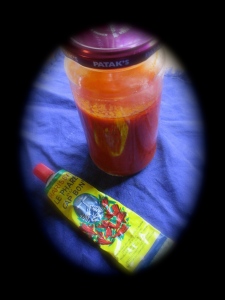Well, success I would say.
Several weeks ago I set myself the task to ferment a jar of peppers– dried, fresh and sweet all together, submerged with some garlic in a salty brine with the intention of an eventual Harissa, my favourite Middle Eastern condiment. I even love the processed stuff that comes in tubes, but wanted to taste a version with that particularly perfect sour fermented flavour, after my good experience with pickling jalapenos in this way. I wrote a blog entry about it and stored the jar on my busy counter tops in the hypothetical section called “In Progress.”
Three and a half weeks later, I noticed that the garlic had become that unsightly blue that sometimes develops in lacto-fermented cloves of garlic. The lovely, ever helpful and knowledgable Sarah of Killer Pickles referred me here to learn that “Garlic contains anthocyanins, water-soluble pigments that can turn blue or purple under acidic conditions. This is a variable phenomenon that is more pronounced for immature garlic but can differ among cloves within a single head of garlic.” Yet it was that blue that told me there’d been enough fermentation ( thus acid production) to proceed. (I was kind of tempted to intensify the blue in photo-edit, and resisted.)
First step was to strain the peppers of their brine, which was fragrant and spicy and sour and bright, and went in as the final splash in the day’s soup, as I’ve described before.
The pepper skins themselves I put in some vinegar for … whatever that turns out to be.
Then as per classic recipes for harissa, I blended the pepper and garlic pulp with olive oil and added ground seeds that I’d sieved to remove the husks: coriander for brightness, cumin for depth, and beloved caraway for a kind of bitter that really levels it all out. Here, in the photo below, I’d drizzled a little extra olive oil.
Well, paste, no– I think if I wanted a paste texture I’d add tomato paste/ puree– not sure how I’d thicken it otherwise. (Any thoughts anyone?) It’s more like a thick sauce, and a really good success of an experiment. It’s a hot spicy with out torment and with various levels of depth. Next time I might ferment the seeds along with the peppers, or perhaps roast them Indian style in the oil at the end. That could bump it all up even more– but I’m not really sure more intensity is called for. In the meantime, I am just really into this idea of fermenting ingredients that then can go on to play a role in grander schemes…






The blue is quite visible, no need to reach for the photoshop! This would be great in a sandwich.
if you have a dehydrator and some of the ‘fruit leather’ sheets, you might could dry it a while to thicken it without heating it up. you could also put some in a cone drip coffee filter and then add the pulp in the filter to the harissa to thicken it. (I make a milk liqueur and strain it with this method. I get a clear final liquid this way and am still trying to figure out something delicious to do with the remaining milk solids.)
What great ideas! Thank you!
Why don’t we have teleportation yet? I want this now! 🙂
very intense flavours, and a deep flaming amber-warmed the heart!
Looks extremely yummy – keep it coming Annie!
Looks wonderful! Harissa is one of my favourite condiments too, I’ll have to try this 🙂
Could you dehydrate the pepper skins then grind them into powder and add to thicken?
what a creative idea! You all are really making me want a dehydrator!
[…] and a pureed hot sauce similar to this one. […]
I’m the founder/moderator for Punk Domestics (www.punkdomestics.com), a community site for those of use obsessed with, er, interested in DIY food. It’s sort of like Tastespotting, but specific to the niche. I’d love for you to submit this to the site. Good stuff!
Thank you, Sean, I will do that. I love Punk Domestics so am honoured.
[…] been making a hot sauce with the flavours of Harissa because it’s so delicious. I pureed the fermented hot peppers and garlic, and whizzed […]
I’m going to make this today! Thank you. I’ll vary it a bit and see how it turns out. 🙂
[…] wanted to make a variation on Harissa, and this recipe from Kitchen Counter Culture is my inspiration for this […]
[…] soup’ jam packed with restorative niceness to make you feel that little bit better. This #fermented #harissa sounds amazing! Thank you for also sharing this #fermented #beetroot elixer. This is particularly […]
[…] with all the recent fermenting of chilli sauces, the harissa, the salsa, the red and yellow and green sauces, I thought– let myself be inspired by this […]
deseo saber donde puedo encontrar su Harissa en las provincia de Murcia o Alicante (España)
Tendrás que hacerlo tú mismo 🙂